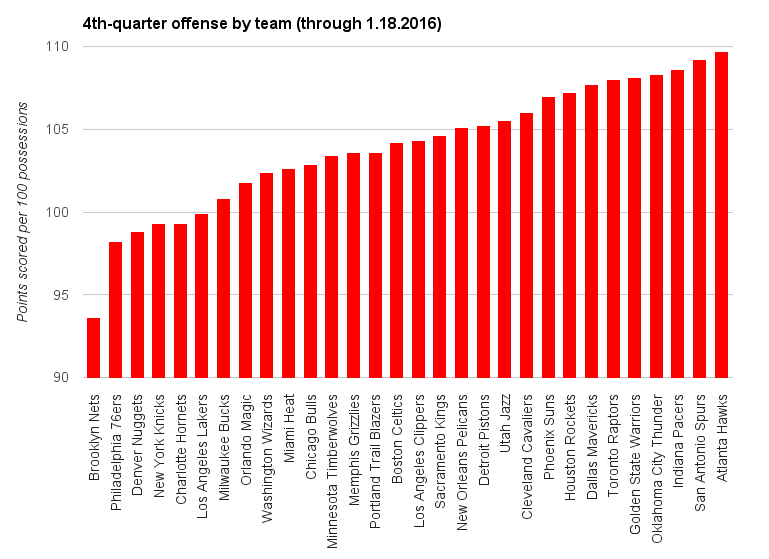
Possibly the only good thing to come out of Wednesday night’s loss for the Nets: they were never in a position to blow a close fourth quarter.
The Cleveland Cavaliers, as you might expect, wiped away the Nets early, leading by as much as 23 en route to an easy 91-78 victory at Barclays Center. Kevin Love, much-maligned for his role in the Cavaliers offense, out-rebounded the Nets in the first half and finished with a game-high 17 points (tying LeBron James) and 18 rebounds. They fell to 11-32 on Wednesday, but against a heavily favored Cavaliers team, didn’t get a chance to show off their biggest weakness: fourth-quarter execution.
Monday night’s fourth-quarter collapse came against Atlantic Division-leading Toronto Raptors. It was their tenth loss on the season after leading a game by double-digits (which they did in the first quarter), and it was hardly in the books throughout: the teams were tied at 98 with 6:34 remaining in the fourth quarter, before Toronto rattled off a 14-0 run to close the game. (Joe Johnson put up two points of window dressing with 1:38 left to close the scoring for both teams.)
14 points by an NBA team in about five minutes of playing time shouldn’t qualify as a run in most circumstances. That’s a good burst of offense, but hardly out of the ordinary. The Nets themselves had scored 14 points in the first five and a half minutes of playing time, about the same rate of scoring.
It’s the zero points by the Nets in the next five-minute stretch that turn this into a run. It’s as problematic as it is orthodox: the team ranks last in the NBA in fourth-quarter offense (93.7 points per 100 possessions), and last in point differential per 100 possessions (-12.5).


Stats via NBA.com. Note: these figures do not include the Cavaliers game. They still rank last in both categories.
The Nets already rank as one of the worst teams in the NBA, beating only the Lakers and 76ers in the win-loss column. But something about those fourth quarters gets even worse. So what’s going on?
Smart passes
Tony Brown cited the turnovers as a major issue.
“We had a couple turnovers, a couple missed shots around the rim, around the basket, missed a long jump shot. You have four, five possessions like that at crucial parts of the game, it’s tough, especially when the other team is going down and they’re scoring every time.
“It’s a dilemma for us, we’re trying to figure out the best way to handle those situations, but number one is not turning over and making sure we get a shot on each possession.”
The Nets have a dearth of talent at point guard already. After Deron Williams unceremoniously walked the plank with $27.5 million slung over his shoulder this summer, the team was left with backup & plus-minus pariah Jarrett Jack, unheralded prospect Shane Larkin, and journeyman Donald Sloan. A step backwards was expected; I thought that Williams (coupled with the loss of Alan Anderson and Mason Plumlee, and additional factors) would cost the Nets about ten wins over the course of the season.
With and without Jack, who’s now lost for the season, the Nets have struggled with late-game execution passing the ball: in the fourth quarter, the team ranks last in assist-to-turnover ratio (1.04) and turns the ball over more than any team (17.7 times in every 100 possessions). A high percentage of those turnovers have been bad passes — about 45%, from Basketball-Reference’s numbers — and most of those have been from the point guards.
Sloan, who has been unusually steady otherwise, has recorded more turnovers per possession in the fourth quarter than any NBA player other than Russell Westbrook, who can do some other relatively useful things with a basketball. Larkin’s airmailed a few passes out-of-bounds, but he’s also prone to getting stuck in traffic with nowhere to throw. Both can fall back on telegraphed passes, which play right into a defense’s hands: just watch Sloan stare down Ellington this entire play, and Lowry anticipates the throw & intercepts it with ease.
It’s not just the point guards, though. There have been a few occasions this season where Sloan or Larkin (or Joe Johnson, or in this next case, Thaddeus Young) throws to a big man who hasn’t established proper position, and an opportunistic defender can swat the pass away.
Missing the right shots
Defenses tend to tighten up in the fourth quarter, as games get closer and mistakes become high-leverage. The Nets are already one of the league’s worst offenses, and rely more and more heavily on shots they struggle to hit as the game gets closer to closing time.
In the last 12 minutes, the Nets take significantly fewer shots in the restricted area and from mid-range, and make that up by taking more three-pointers. Some of that’s explained by them, like any team, firing away threes late in a blowout loss. But generally, it’d be a good thing to take higher-percentage shots in the fourth quarter, right?
Not for these Nets, who have been far worse at converting three-pointers in the final frame. The team has shot an ugly 38-148 (25.7%) on above-the-break threes in the fourth quarter. That’s brought their entire average down. The team shoots best in the first and third quarters, but falls apart in the second when their bench comes in, and then in the fourth with the game on the line.
Of their shooters, only Shane Larkin (40%) and Joe Johnson (34.1%) are shooting above 33 percent from 3 in the fourth quarter.
At this point in the season, the Nets aren’t looking for wins. They’re just looking for answers: winning combinations they can take into next year, sets and shooters that’ll stick in the rotation, and figuring out which players to keep and which players to set loose. If they can figure out how to fix the fourth, maybe they can figure out who sticks beyond this season.


















